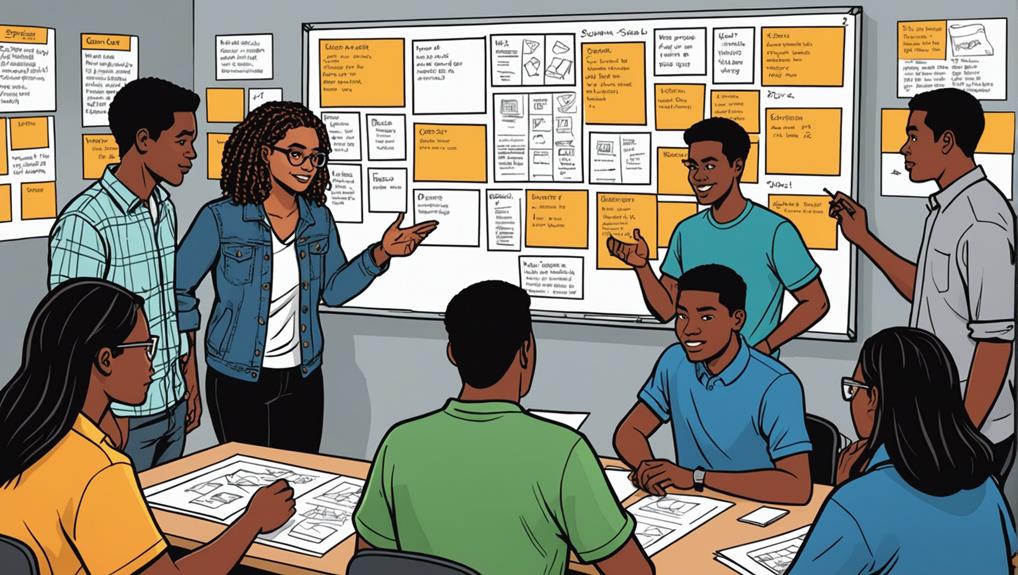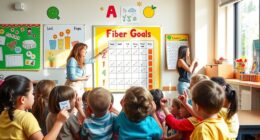Empower educators by mastering target setting with SMART strategies. Specific, Measurable, Achievable, Relevant, and Time-bound targets guide students to success. Witness the transformative power of goal setting in Lucy's journey from a U to A* in chemistry. Flexible planning and well-formed outcomes complement SMART targets for unparalleled student development. Engage with educational communities like the Richard Rogers group for shared insights and camaraderie. Immerse yourself in a world of academic progress and personal growth with structured target setting. Explore the impact firsthand and unleash the potential for a fulfilling educational experience.
Key Takeaways
- Incorporate SMART targets for clear, measurable, and achievable goals.
- Utilize well-formed outcomes to consider students' emotions, values, and relations.
- Engage in mental rehearsal and thorough goal setting for enhanced target efficacy.
- Collaborate with online educational communities for support and diverse perspectives.
- Foster community engagement to share resources, insights, and collective problem-solving.
Importance of SMART Target Setting

Setting SMART targets is a fundamental practice that empowers educators to guide students towards meaningful academic progress and personal growth.
SMART targets, being Specific, Measurable, Achievable, Relevant, and Time-bound, play an essential role in student development.
By setting SMART targets, educators provide students with clear objectives that are within reach and align with their aspirations.
These targets not only enable students to track their progress but also instill a sense of purpose and accomplishment.
Through SMART targets, students learn the importance of setting goals that are both challenging and realistic, fostering a mindset of continuous improvement.
Ultimately, SMART targets serve as a roadmap towards success, encouraging students to aim for excellence while enjoying the journey of learning and growth.
Student Success Stories and Benefits

Student success stories exemplify the transformative impact of goal setting and achievement within academic contexts.
Take Lucy, for example, who went from a grade U to A* in chemistry through SMART target setting. Her journey showcases how setting Specific, Measurable, Achievable, Relevant, and Time-bound goals can boost belief in one's capabilities. By articulating and working towards clear targets, Lucy experienced significant progress.
Such success stories highlight the power of setting and achieving incremental goals. They demonstrate that with determination and well-defined targets, students can surpass their own expectations and reach new heights academically.
These stories not only inspire others but also serve as a confirmation to the benefits of structured goal setting in education.
Overcoming Time-bound Target Challenges

Lucy's remarkable academic journey highlights the significance of addressing challenges related to setting time-bound targets in educational settings. Overcoming time-bound target challenges is essential for educators to guarantee student success.
Here are some practical strategies to tackle these obstacles:
- Utilize a year-long assessment plan: Create a detailed plan with topic lists to help set achievable time-bound targets.
- Adapt to school events and lesson paces: Be flexible in adjusting assessment schedules to accommodate unforeseen disruptions.
- Modify assessments for better planning: Alter topic lists as needed to assist students in planning effectively for assessments.
- Maintain clear assessment plans: Despite challenges, maintaining clear plans with specific targets is key to tracking progress effectively.
Enhanced Strategies for Target Setting

Utilizing well formed outcomes alongside SMART targets can elevate the efficacy of target setting strategies in educational settings. Researchers like Trevor Day and Paul Tosey advocate for incorporating well formed outcomes into goal setting practices.
Well formed outcomes take into account learners' identity, emotions, social relations, and values, providing a more holistic approach to setting targets. By encouraging mental rehearsal and thorough goal setting, well formed outcomes complement the specificity of SMART targets.
The combination of these strategies enhances the depth and effectiveness of target setting processes, fostering a more profound impact on student development and achievement. Educators who integrate well formed outcomes with SMART targets are better equipped to inspire and guide students towards meaningful and attainable goals.
Community Engagement and Collaboration

Incorporating community engagement and collaboration into educational practices can enrich the target setting process by fostering a network of support and shared resources among educators.
Joining online educational communities like the Richard Rogers group on Facebook and Twitter can provide a platform for daily insights and updates.
Connecting with like-minded individuals and educators in these communities can offer a sense of camaraderie and shared experiences.
Sharing valuable content and resources with others not only contributes to the community but also allows for diverse perspectives and ideas to enhance target setting strategies.
Collaborating with colleagues can lead to meaningful discussions, idea exchanges, and collective problem-solving, ultimately improving the overall target setting process.
Frequently Asked Questions
How Can Educators Adapt Target Setting for Students With Different Learning Styles?
Educators need to adapt target setting by recognizing diverse learning styles. Tailoring targets to visual, auditory, kinesthetic, or other preferences can enhance student engagement and success. Flexibility, individualization, and varied assessment methods are key in accommodating diverse learners.
What Role Does Self-Reflection Play in Effective Target Setting for Educators?
Self-reflection plays a pivotal role in effective target setting for educators. It fosters self-awareness, guides professional growth, and enhances instructional strategies. Educators who engage in regular self-reflection can tailor targets to meet diverse student needs, fostering improved learning outcomes.
How Can Educators Ensure That Targets Align With Individual Student Needs?
Traversing the educational landscape, educators craft targets as artisans mold clay. Personalizing each goal to fit the unique contours of student needs is paramount. Through tailored aspirations, educators illuminate pathways to student success.
Are There Specific Techniques to Help Students Track Progress Towards Targets?
To help students track progress towards targets, educators can implement progress charts, regular check-ins, student self-assessment tools, and digital platforms for tracking. These techniques promote accountability, motivation, and a clear understanding of goal attainment.
How Can Educators Leverage Technology to Enhance Target Setting Strategies?
Educators can leverage technology by implementing online platforms for personalized goal tracking, real-time progress monitoring, and interactive feedback mechanisms. Technology enhances target setting strategies by providing data-driven insights, fostering student engagement, and facilitating continuous improvement.
Conclusion
In summary, as the saying goes, 'Aim for the moon, even if you miss, you'll land among the stars.'
Mastering target setting strategies, particularly SMART targets, is essential for educators to empower students and drive success.
By setting clear, achievable goals and overcoming challenges with enhanced strategies, educators can guide students towards tangible outcomes and foster a supportive learning environment.
Through community engagement and collaboration, educators can enhance their proficiency in setting meaningful targets, ultimately leading to student growth and achievement.









